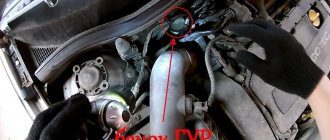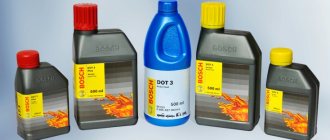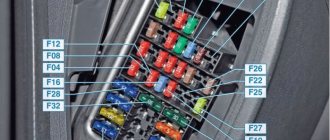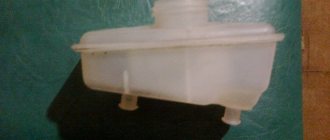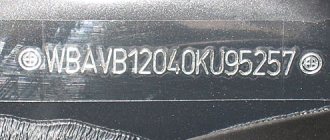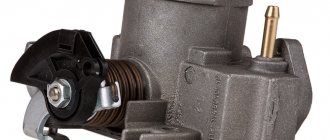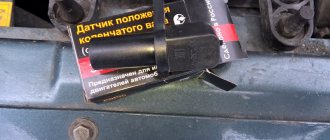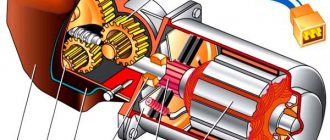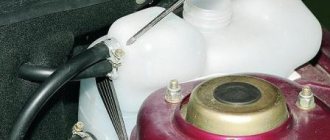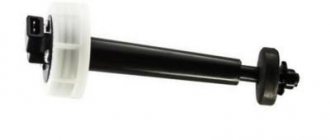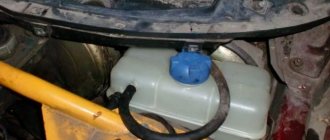Reason for the car owner's request LADA Priora
At the service station there was an extraneous noise when the steering wheel moved.
During diagnostics, a humming sound from the power steering pump was detected. Apparently its work has come to an end, or the power steering
has been changed very rarely (the recommended frequency
is 50-60 thousand kilometers
).
You can try to simply change the fluid to the original one or try to temporarily restore the pump, but it is better to immediately replace the power steering
on the Priora and not waste time. In addition, it is cheaper than buying fluid and a repair kit twice.
What kind of oil should I put in the Priora power steering?
What kind of oil to fill in power steering
It is not possible to fill the power steering with any oil. The difference between PSF and ATF is huge. The requirements for it are even greater than for the engine. It must be exclusively mineral water or synthetic, as well as a certain viscosity and properties
From the factory, light green Pentosin CHF 11S
, the cost of which is more than 1000 rubles per liter.
Original article 00001-7504780-00-0
(price 1200 RUR).
The manufacturer recommends using only original fluid for power steering
, so the manual makes a note that using a fluid other than
Pentosin Hydraulik Fluid
CHF 11S-TL VW52137 may result in...
We chose the synthetic gear oil “DEXRON III AUTOMATIC PLUS” from Mannol. Article 1 l
bottles of power steering fluid - AP10107.
The average market value is 390 rubles. It can also be liquid FEBI 6161
(price 500 rubles)
How much oil is in power steering Lada Priora
For a Priora with power steering, the expansion tank will need ~0.7 liters
liquids. When the system is completely pumped and flushed, the entire liter bottle can be used.
List of required tools
- Lift;
- 13 mm
hex head ; - The ratchet is large;
- Open-end wrench for 17, 22 and 27 mm
; - Crosshead screwdriver;
- Sprocket T25
.
How to change the Priora power steering pump with your own hands (removal and replacement)?
- Unscrew the bolt securing the side protection - T25
; - Move the guard to the side;
- Loosen the drive belt roller nut using a 17 mm
; - Raise the car;
- Remove the belt from the pulley;
- Remove the pulley - 13 mm
; - Unscrew the pump fastenings - 13 mm
; - Remove the clamp of the incoming oil pipe - a Phillips screwdriver;
- Pull out the pump;
- Remove the oil supply pipe fitting - a 22 and 27 mm
; - Remove the power steering
; - Compare with new pump;
- Install a new pump;
- Lower the car;
- Open the power steering reservoir cap;
- Fill in 0.5
power steering fluid; - Pump liquid through the system;
- Top up until full ~ 0.2 liters
; - Pump until liquid stops coming out.
Torque:
- Power steering pump mounting bolt - 30-40 Nm
; - Power steering pulley bolts - 30-40 Nm
; - Fitting nut - 60-70 Nm
.
Unscrew using a T25
side protection bolt. We take her aside.
Find the drive belt tension roller nut. 17 mm open-end wrench
.
To gain access to the drive belt, lift the car.
Remove the drive belt from the power steering pulley.
The next step is to remove the power steering pulley. Unscrew 3
pulley fastening nuts
with a 13 mm
.
Remove the power steering pulley from its seat. The three power steering mounting bolts were opened. We unscrew them with a 13 mm
.
There are three more bolts on the back of the power steering. We dismantle the fastenings.
Using a Phillips screwdriver, unscrew the clamp securing the inlet pipe.
Place a container or oil receiver under the power steering pump and drain the oil. In order for the power steering fluid to come out as much as possible, you need to manually turn the wheel left and right.
Driving a car used to be quite a difficult task. The power steering, also known as power steering, of the Lada Priora makes the steering wheel of the car light. The electric booster is even lighter, but not more informative. Priora is equipped with and power steering. The amplifier operates using liquid, so in comparison with an electric amplifier, you need to monitor the level. On Priora, the assembled part will cost more than 7 thousand. The price is for the kit - it consists of 11 parts. Constantly being on the road tires you not only with emotional fatigue, but also with the incessant movement of the steering wheel, gear lever and pressing the pedals. To reduce the load on muscles, various systems are built into cars. Some of them make the pedals “lighter”, while others make it easier to turn the steering wheel.
The power steering for the Priora car has become a real salvation; the steering wheel has become lighter and more comfortable to use: to make a turn, you don’t need to use too much effort, tiring yourself. The power steering immediately picks up the force that the driver applies to the steering wheel and begins its work.
However, the mechanism requires attention: at certain moments it is necessary not to forget about replacing the Priora power steering fluid. Also, after a couple of years the hose cracks, so replacing the power steering hose in a Priora car is a matter of 3-6 years.
Installing power steering - step by step instructions
This instruction is intended for VAZ 2110 cars, which do not have power steering at all. Such models were produced a long time ago, but they can still be found on the road today. In this case, the car can be upgraded with your own hands.
You can install the power steering yourself; for this you will need a power steering kit - today it can be purchased for about 20 thousand. From the tools, prepare a set of keys and screwdrivers; you should also take care of the amplifier fluid in advance.
- We dismantle the timing case and install the bracket on three bolts. There are already holes in the interior, so there is no need to drill new ones. Now we install the pin on which the roller will later be installed. There are no holes for it, so we make new ones. Let's put on a video.
Standard power steering (hydraulic booster) - article number and price
The standard power steering for the Priora received catalog number 21230340701200, the cost is from 7,500 rubles. Before ordering and purchasing, you should check the availability of fasteners. But the system itself is sold for spare parts:
- Long oil tank strap - 21100341010500 - about 500 rubles.
- Oil tank bracket - 21100341010000 - about 150 rubles.
- Power steering tank - 21230341001000 - about 900 rubles.
- Supply pipe - 21100340812500 - about 1,000 rubles.
- Power steering pump - 21100340700900 - about 6,000 rubles.
- Pillow – 21100340804000 – about 400 rubles.
- Low pressure pipe – 21100340804000 – about 400 rub.
- High pressure hose with tube – 2110034801810 – about 1,900 RUR.
- High pressure pipe – 21100340808001 – about 900 rub.
- Low pressure hose with tube – 21100340802600 – about 1,800 RUR.
- Front high pressure hose – 21100340810010 – about 1600 rub.
Power steering reservoir with filter
The standard power steering reservoir on Lada cars is non-separable (manufacturer: ZF). There is a filter inside it, which is a fine mesh. If you think that such protection is not enough, install a power steering reservoir from Volga (GAZ 3110), catalog number: 3105-3407178. There are two types to choose from:
- plastic (non-separable) power steering reservoir with built-in filter (price 150 rubles);
- metal power steering tank with a replaceable filter (tank price is about 500 rubles, replaceable filter 40 rubles).
No modifications are required to install it, because... The tank from Volga and ZF are almost the same in size and have two pipes (inlet and outlet) with the same diameters. Replacement using the example of a VAZ 2110 car, where the power steering is like on a Priora.
Let us remind you that AvtoVAZ installs electric power steering on other Lada cars (Granta, Kalina, etc.). If malfunctions occur, you can diagnose the EUR yourself.
What does the power steering system consist of and how does it work?
The Priora's power steering works in the steering system. Its main part is the pump. The system fluid circulates in a special tank, pipes, and hoses that can withstand high pressure.
The operation of the hydraulic booster depends on the quality and “purity” of the corresponding working fluid in the system. When the driver turns the steering wheel, the pump increases the pressure of the working fluid, and it pushes the piston, increasing the force on the steering rack. In this case, the force that develops thanks to the pump is proportional to the resistance force that acts on the wheels - be it off-road or on a free track.
It turns out that at high speed the Priora’s hydraulic booster practically does not work - changing lanes or turning requires the least effort. A special torsion bar device, which is part of the steering mechanism, helps to properly distribute the resulting forces. Having received a signal in time that the created pressure is sufficient, the pump stops its operation, and sufficient auxiliary force is created to turn the steering wheel. It turns out that while driving, the driver constantly needs to act on the steering wheel with the same force, because the power steering always minimizes the impact of the opposing force.
Replacing power steering hoses for VAZ 2112
“Guys, who changed the high-pressure hoses? To change the hose from the pump to the rack, you need to remove the steering rack?” This was the initial post in the process of replacing those same hoses.
In the morning I looked under the hood and saw that the SHVD that goes to the rack was sweating, and not just sweating, but covered in oil. I started looking at others, and the result was that they were all damaged. It was decided to replace it. A set of all hoses is about 1500 of ours. I took it. I started reading about the replacement, there is no real manual anywhere, only for bleeding the system, they only write that they say remove the old ones, install new ones, half an hour of work. Well, okay, I think, for a couple of hours of painstaking work. So, we pump out the old slurry with a syringe, since we will fill it in (no). It’s very strange, but when I changed the power steering pump about 3 months ago (my old one was jammed), I immediately changed the fluid, but for some reason during this period it all became the color of waste. Husim. We drop the tank, then we need to remove the generator, there’s no other way, it’s the pump underneath it, and therefore the fitting that needs to be unscrewed, but that’s okay, 10 minutes of work. Then everything rests on the rail, I moved my fingers along the path of the tube, no one understands what is there and how. I started looking on the Internet, there was nothing, whether it needs to be removed or not, but if you take it off, you can’t do it in 1.5 hours. Thanks for your help in the comments, the one who really needs to remove it is the one who has the new hoses. From the old to the easy this whole replacement. But I didn’t remove the rack completely, I disconnected it from the steering column, unscrewed the rods and 2 clamps, pulled it out of the boot and simply (not very easy, I’ve never sworn so much in my life) rotated it under the hood so that I could unscrew this evil fitting.
I unscrewed the left rack clamp without any problems, it is attached with 2 nuts, just like the right one, and I unscrewed the nut of the right clamp along with a piece of bolt. The bolts there are welded in from the factory (like studs, only welded). It’s not so bad that the second bolt of the same right clamp was torn off before me. As a result, we were left without the right fastening. Let's knock out the remains of the top bolt with a chisel (it worked, I picked up a new bolt, somehow drove it through this hole, unfortunately there is no photo), everything is fine with the top one. A piece of the lower one had to be drilled out and, by analogy with the first one, a new bolt (somehow), a nut and order. All this took about an hour. Next came the assembly, then I had to go get new oil (550 rubles), then fill it and pump it. In the end, all this fuss took me about 6-7 hours. This was my first time filming Reika. It’s not so hot to work without a manual, everything is by touch. Thanks for your comments.
The power steering pump is designed to pump oil into the steering mechanism and ensure fluid circulation in the system. During rotation, the pump shaft and blades create a centrifugal force, as a result of which the working fluid enters the discharge cavity under high pressure and then into the power steering system. The power steering pump is mounted on the engine and driven by a belt drive.
As a rule, replacing the power steering pump is carried out in conjunction with changing the oil, clamps and hoses. In this article we will look at how to perform this procedure with your own hands using the example of a VAZ-2110 car.
Main faults of the hydraulic booster on a Lada Priora car
When operating a Priora with power steering, the following problems may occur:
- When turning the steering wheel, a feedback is felt, similar to a push in the opposite direction (replacing or tightening the drive belt will help);
- It is difficult to turn the steering wheel (replacing or tightening the belt will help; adding fluid to the tank to the normal level, replacing or cleaning the filter; replacing the pump; removing the air lock or adjusting the idle speed);
- The steering is too “smooth” (adding fluid, removing the air lock and checking the steering, changing the tires will help);
- Extraneous noise during operation of the power steering (adding fluid, removing air lock or mechanical damage, checking the pump and replacing it will help);
- The steering wheel vibrates with weak shocks (removing the air lock in the system, balancing the wheels or changing the tires will help).
Repair: removal and installation of power steering Lada Priora
Replacement of Gur Priora and its repair must begin with correct diagnosis. It is also worth inspecting the reservoir of pipes and hoses in order to notice any damage in time. To remove the power steering you will need:
- stopper for retaining rings;
- key 12, head 14, 24;
- new bearing;
- syringe and container for draining liquid;
- fine-grained sandpaper and clean rags.
Working with power steering requires care - the system must remain sealed. The low pressure hose (2110 3408026 – article number) is often damaged. Therefore, the reason for the intrusion into the power steering system is the replacement of the Priora power steering hose. Repair work is carried out as follows:
- Park the car on level ground, tighten the handbrake, remove the negative from the battery.
- Find the hole in the pulley and unscrew the mounting bolt that secures the pump;
- Use a syringe to pump out the oil from the system. At the same time, rotate the steering wheel in different directions so that the liquid comes out of the hoses;
- Loosen the clamp attached to the reservoir hose. Take out the hose;
- Remove the bolt that secures the high pressure hose;
- Remove the bolt and replace it with a metal rod of the same diameter.
- Take out the pump, clean it of dirt, you can clean all the systems connected to it of dirt.
- If repair or replacement of the system is required, after repair, reassemble everything in the reverse order.
Replacing the power steering fluid of a Lada Priora car step by step instructions
To change the power steering fluid of the Priora, it is highly recommended to call a friend and partner. You will have to perform several operations simultaneously. For convenience, it is recommended to place the car in a pit or raise the front of the car on two supports using a jack. Prepare a container to drain the used fluid. Carry out work on replacing the Priora power steering fluid in the following order:
- Secure the car.
- Remove the power steering reservoir cap. Place the syringe into the tank and gradually pump out the liquid accumulated in it. For convenience, before putting the syringe into the tank, it is recommended to put a small hose on it. It is also recommended to cover with a cloth the entire engine compartment over which you will carry the syringe with oil to the container, so as not to pour in excess drops.
- Ask your partner to get into the car and turn the steering wheel. At this time, suck out the liquid that flows into the tank from the hoses.
- But that is not all. To collect the remaining oil, loosen the clamp of the high pressure hose, grab the hose, and lower it into the drain container.
- Ask your partner to turn the steering wheel again.
- Reinstall the hose and tighten the clamp tightly.
- You only need to fill in new fluid. First, fill it almost to the top, and then ask a friend to turn the steering wheel. The fluid level will drop, but this is normal. Add a little more, leaving a few centimeters up to the throat.
- Have someone start the engine for 10-20 seconds and then turn it off. After this, you need to turn the steering wheel again. During this time, the remaining air will leave the system.
- Add oil to the normal level. Screw on the tank cap and close the hood.
- Start the engine. Check if the power steering works as well as it did before.
Hydraulic and electric power steering are designed to ease the effort the driver makes when turning the steering wheel. The EUR is a more advanced mechanism compared to the power steering, since it uses an electric drive. The system does not contain oil or other hydraulic components, which increases its reliability. Typically, AvtoVAZ engineers install electric steering systems on passenger cars, and less often - power steering. Both types of power steering are found on the Lada Priora.
Steering diagram
How to pump power steering
How to fill oil and bleed power steering
The procedure for replacing fluid and pumping power steering is carried out in strict accordance with the existing algorithm. Some automakers may add their own features to it. If you have a manual for your car, we recommend that you read the relevant section. In general terms, the steps must be performed in the following sequence:
- Raise the vehicle completely on a lift or with the front wheels off the ground.
- If necessary, drain the old fluid from the expansion tank. To do this, remove the return hose (going to the power steering system) from the expansion tank and put a plug on it so that liquid does not spill out of the hose. A hose leading to an empty bottle is connected to the released tap on the tank, where the old hydraulic fluid is supposed to be drained.
- It is most convenient to pump out the main volume of liquid with a syringe and pour it into a separate bottle. When there is very little liquid left, move on to the next point.
- Fill the expansion tank with working fluid to the top.
- Next, you should turn the steering wheel from side to side (from lock to lock) several times so that the old fluid remaining in the system flows out through the hose. Since the new fluid displaces the old, do not forget to monitor the oil level in the tank so that air does not get into the hose.
- If the fluid level drops, add it again.
- Start the engine for 2-3 seconds and turn it off. This is done so that the liquid begins to spread throughout the system.
Pumping out oil with a syringe
- Next, add working fluid to the tank to the MAX level and repeat the procedure by starting the engine. Repeat this cycle 3-5 times.
- The signal to stop pumping is the fact that air from the return hose stops entering the drain bottle. This means that there is no more air left in the hydraulic system and fresh, clean fluid enters the reservoir.
- After this, you need to reinstall the return hose (connect it to the expansion tank where it was originally installed).
- Refill the reservoir to the MAX level, then start the engine.
- To pump the hydraulic booster, you need to slowly turn the steering wheel 4-5 times from the left to the right stop. At the stop points, pause for 2-3 seconds. If there is any air left, it should escape into the expansion tank. During the inspection process, we make sure that the pump does not make any extraneous noise.
- An indicator that pumping has ended will be the absence of air bubbles on the surface of the liquid in the tank.
- After this, close the expansion tank tightly.
The design and principle of operation of the Priora steering mechanism
On front-wheel drive vehicles, due to their design features, it is impossible to install a classic steering mechanism. The first thing engineers encounter is lack of space. A standard mechanism cannot be installed, even if a transverse engine is used instead of an in-line engine. For this reason, the classics, which are not distinguished by modest dimensions, have been replaced by a compact steering rack, which transmits the force when turning the steering wheel to the front wheels.
To save as much space as possible, on Priora and many other cars the rack is rigidly fixed to the front panel of the engine compartment - between the engine and the passenger compartment. It connects to the steering column, which extends into the cabin and ends with the steering wheel. The steering rack is a toothed metal rod. Its teeth engage with the steering wheel drive in the form of a shaft. They are located relative to each other at right angles. This is an improved worm drive.
The driver rotates the steering wheel along with a shaft, the teeth of which move the steering rack inside the casing, engaging with a toothed rod. There are holes in the rack casing through which the steering ends (rods) are connected. In the center of the rack itself there are holes for attaching these tips, which are attached to the steering knuckles of the front wheel strut using rods and special levers.
Design and operating features of power steering and power steering
To make steering easier to turn and increase comfort, either hydraulic or electric power steering can be used. Both amplifiers have both pros and cons.
Structurally, power steering is a system of high and low pressure hoses containing oil driven by a pump. Power steering fluid must be poured into the reservoir near the pump. It only works when the engine is running. The driver turns the steering wheel, and at this time the fluid flows through the distributor under pressure created by the pump to the steering mechanism. It enters the working cylinder, puts pressure on the piston, which begins to move, and facilitates the rotation of the steering wheel. When moving in a straight line, the liquid flows back into the system reservoir.
Power steering diagram
Advantages and disadvantages of power steering
In the case of a hydraulic booster, the main disadvantage is the bulkiness of the entire system. But it is cheaper to produce and maintain, and this affects the price of the car. At the moment, power steering is found mainly on budget class cars, which include Priora. An amplifier of this type is also installed on expensive, powerful SUVs. This is explained by the fact that the power steering is capable of transmitting greater torque transmission power to the steering. In this regard, it outperforms an electric booster, but there are still more disadvantages:
- In a car equipped with a hydraulic booster, it is not recommended to hold the steering wheel in the extreme right or left position for more than 5 seconds. Otherwise, the oil in the power steering on the Priora begins to heat up, which can lead to system failure.
- The mechanism requires constant monitoring of the oil level, inspection and replacement of drives, hoses, and pump.
- The pump depends on the operation of the engine, which means it takes a certain percentage of power from the power plant. If the power steering does not work when driving in a straight line, this percentage of power is wasted.
- Such a system does not imply setting operating modes depending on the speed of movement or the angle of rotation of the steering wheel.
- At low speeds, the steering mechanism provides good sensitivity, but at high speeds it becomes less pronounced.
Engineers compensate for the last drawback by using a steering rack with a variable gear ratio. Power steering has already become an outdated system; designers are no longer involved in improving it.
Electric amplifier design
The design of the EUR is simpler than that of the power steering. It consists of an ECU, a torque sensor, a steering angle sensor and an electric motor. There are no hoses or fluids here. The electric motor is mounted directly on the steering rack itself, and torque is transmitted to it via a torsion shaft built into the steering mechanism system.
In the case of power steering, the force is facilitated by liquid, and in the electric booster the current is responsible for this. When the driver turns the steering wheel, force is transmitted to the steering rack. At this time, the torque sensor transmits data to the electronic control unit. The controller calculates how much current needs to be sent to the electric motor to optimally facilitate steering rotation. Since the force must be uniform, the speed of movement and the angle of rotation of the steering wheel are taken into account.
If the steering wheel rotates without the vehicle moving or at low speed, as when parking, the electric motor receives maximum current and the steering wheel turns easily. When driving at medium and high speeds, such force is no longer required, and the controller supplies a lower current.
Pros and cons of EUR
The electric booster is a more modern system with high potential for modernization. It is not without its shortcomings, but there are fewer of them than the power steering:
- high price,
- The electric motor cannot provide high power, so it is installed only on passenger cars.
The disadvantages are leveled out, since the design of the electric amplifier is constantly being improved.
The EUR for the Priora has many advantages. The system is easy to maintain due to its simple design. The only part that requires inspection is the rolling bearing. The ESD mechanism has more compact dimensions and can be installed on the steering shaft in the cabin, freeing up space in the engine compartment. Due to this, the durability of the structure increases, since there is no exposure to temperature changes and high humidity.
The electric booster does not take power away from the engine, which saves fuel. The drive only operates when the steering wheel is turned. The ECU is responsible for the operation of the amplifier, with the help of which you can adjust the operating mode of the EUR, taking into account the operating conditions of the vehicle. The electric booster is not afraid of extreme steering positions. Driving at high speed makes the steering wheel with ESD more sensitive.
Priora steering rack malfunctions
Problems with the functioning of the steering rack can be different. To identify them, it is not necessary to have a wealth of special knowledge; it is enough to periodically inspect the mechanism.
Large steering play
If you turn off the engine and actively turn the steering wheel, there should be no extraneous sounds. When not only suspicious noises appear, but also play is observed, the cause of the problem may be a weakened spool stop or insufficient elasticity of the torsion bar. The steering wheel may play due to severe wear of the silent blocks on which the steering rack is fixed. The same problem occurs when the angle of contact between the teeth and the screw is incorrect, or the curvature of the crankcase or shaft is caused by damage or the stroke of a screw-type bearing. To determine the malfunction, you will need to diagnose the rack bushing, steering rod joints and teeth.
The appearance of knocking and heaviness when turning the steering wheel
The steering wheel becomes heavy due to a soured cardan, but most often it is the knocking that occurs. There are a number of characteristic reasons for this phenomenon:
- noise occurs during the movement of the vertical bearing shaft;
- excessive wear of joints and crankcase;
- exhaustion of the life of a screw bearing, bushing or teeth;
- crooked shaft or crankcase, as a result the screw contacts the teeth with an offset angle;
- wear of silent blocks;
- loose rack fastening;
- steering wheel play.
In any case, you will need to carry out diagnostics, and if malfunctions are identified, you will need to dismantle and repair the Priora steering rack with replacement of worn elements.
Worn steering shaft center tooth
Wear of the mechanism with teeth occurs quite often. The main purpose of the steering shaft is to convert rotational motion into translational motion. Most cars are characterized by the exhaustion of the resource of the central teeth. The reason is simple: movement in city traffic is determined by driving in a straight line with slight deviations of the trajectory to the left or right.
To determine the malfunction, you need to swing the steering wheel to the sides from the middle position. If knocking noises are heard, it is better to carry out further diagnostics at a service station. If the central tooth is worn excessively, the entire shaft must be replaced.
Problems in the operation of the hydraulic booster
All breakdowns of the Priora power steering, as well as the causes and methods of eliminating them, are listed in the table:
| Malfunction | Cause | Remedy |
| When turning the steering wheel, you feel a kickback (shocks in the opposite direction) | Worn or loose pump drive belt | Replacing or adjusting belt tension |
| It takes a lot of effort to turn the steering wheel. | The pump belt is worn or loose. Low fluid level in the reservoir. The fluid reservoir filter is clogged. Low pump pressure or air lock in the system. Insufficient engine idle speed. | Adjust or replace the drive belt. Add liquid to the reservoir. Replace or clean the filter. Replace the pump. Remove the air lock. Adjust idle speed. |
| More effort is required to rotate the steering wheel in the middle position | Pump or steering mechanism faulty | Check, repair or replace the pump. Find and fix the steering mechanism problem |
| More effort is required to turn the steering wheel to one side | The pump has failed | Pump repair or replacement |
| Steering is unclear | There is not enough fluid in the reservoir or it is leaking. Air in the power steering system. Resource development. | Add fluid and fix leaks if any. Remove the air lock. Check steering components and replace if necessary. Replace tires. |
| It takes a lot of physical effort to quickly turn the steering wheel | The belt tension has weakened. Air in the system. The pump is faulty. Failure of parts of the steering mechanism. Floating idle speed. | Pull the belt. Remove the air lock. Replace the pump if it cannot be repaired. Check and eliminate faulty parts of the steering mechanism. Adjust idle speed. |
| Noise during power steering operation | There is not enough liquid in the tank. The liquid is discharged through the safety valve (a whistle is heard when the steering wheel is turned to the extreme position). | Add fluid and fix the leak. Remove the air lock. Check the pump pressure, repair or replace the part. |
| Steering wheel vibration | Airlock. The wheels are out of balance or the tires are damaged. | Remove air. Balance wheels or replace tires |
In practical terms, power steering is more often replaced with a new one or with a known good one. The original device costs a lot, so they choose analogues. Models from Chinese manufacturers have proven themselves to be an inexpensive option of good quality.
How to pump power steering
Air in the power steering system is dangerous:
- completely changes the operating characteristics of the drive;
- The steering force when rotating is uneven - the driver cannot perform the maneuver accurately;
- The steering wheel is locked in the extreme left or right position, making it impossible to control the car.
How to remove air from the system?
- Raise the car on a lift or hang the front wheels.
- Check if the hoses are torn, make sure that the clamps and pipes are securely tightened.
- Fill the reservoir up to the max mark.
- Start the car for a few seconds to allow the fluid to circulate throughout the system. Add fluid to the maximum and start the car again.
- Fill the tank to the maximum, start the engine. Monitor the oil level and add it as necessary.
- When the oil stops noticeably leaving, turn the steering wheel left and right until it stops several times.
- Turn off the car and repeat the procedure after 5-10 minutes.
Changing power steering oil
If no bubbles form on the surface of the liquid in the tank, there is no air in the system - you can screw on the cap.
How do you know when it's time to bleed your power steering system?
Bleeding the power steering is the first thing to do if the power steering is noisy, foam has appeared in the storage tank, and the steering wheel turns on its own or, conversely, has become stiff.
Electric amplifier breakdowns
To diagnose a malfunction of the electric amplifier, you first need to determine the conditions under which the problem arose. There may be several of them:
- the failure occurred after discharging and then charging the battery;
- after turning the steering wheel at a large angle;
- when performing a parking maneuver;
- when driving at speeds above 110 km/h.
Based on these reasons, we can draw a conclusion about the nature of the occurrence of malfunctions. Often the cause of malfunction is low voltage of the on-board network. For normal operation of the EUR, the voltage must be at least 13.5 V. First, the battery is checked. If it is working, it is possible that the on-board network was de-energized after the battery was removed for recharging. To resume work, sometimes it is enough to turn the steering wheel 5-6 times to the extreme positions and back.
If everything is fine with the battery, you need to check the insulation of the wiring and connections for short circuits. The EUR on the Priora does not work in constant mode, like the power steering. The maximum load on the electric motor occurs when the steering wheel rotates at low speed or the car is stationary; the minimum load occurs when driving at speeds over 100 km/h. After reaching 110 km/h, the electric booster does not work at all.
If you hear knocking or other suspicious sounds while driving when turning the steering wheel, the fastening nut may have become loose - it needs to be lubricated and tightened. To do this, you need to dismantle the apron under the steering wheel and remove the casing. Sometimes a situation may arise when the wheels turn spontaneously. This directly indicates a malfunction of the electric power steering control unit.
The main problem with the EUR Lada Priora is that in order to reduce the cost of the design, a high-quality German-made electrical circuit was replaced with a domestic analogue, modified, but “crude”.
If the amplifier and speedometer do not work, then the problem is in the speed sensor - it is either dirty or faulty. The same goes for torque and steering angle sensors. First you need to clean them and reset errors from the on-board computer; for this you can use several methods:
- remove the terminal from the battery, de-energizing the on-board network;
- using diagnostic programs and an adapter for connecting to the OBD II diagnostic connector.
If you suspect that a fuse has blown, it should be checked and replaced if necessary. It is located in the mounting block, in the cabin, below the steering wheel on the left side. If any of the listed malfunctions occur, you can fix them yourself, but to completely replace the electric power steering mechanism, it is better to contact specialists.
Typical power steering malfunctions
Malfunctions in the operation of the hydraulic booster can be easily identified by characteristic signs. Among them:
- The steering wheel turns hard . Probable causes are failure of the power steering pump, use of unsuitable working fluid, sticking of the spool mechanism channels.
- , a high-frequency sound (similar to a whistle) is heard while driving The probable cause is a loose drive belt.
- The steering wheel turns jerkily . Probable causes of the malfunction are the working fluid not meeting the specifications declared by the manufacturer, a malfunction of the fluid distributing mechanism, or a pump malfunction.
- The presence of intense foaming in the expansion tank. Probable causes are mixing of different types of fluids, failure of the power steering pump.
- When the engine is running, the steering wheel spontaneously turns in any direction . The probable cause is malfunction of the spool mechanism, most often, clogging of its working channels, incorrect assembly (for example, after installing a repair kit).
Recommendations for operation and maintenance of power steering
In order for the power steering and its system to operate normally, as well as to extend their service life, you must adhere to several simple rules:
- use working fluids recommended by the automaker , and also replace them in a timely manner (most automakers recommend replacing power steering fluid every 60.120 thousand kilometers, or once every 2 years, it depends on the driving style and intensity of use of the car);
- carry out bleeding of the power steering system in strict accordance with the algorithm described above (or observing individual requirements, if any are set by the car manufacturer);
- monitor the condition of the steering rack boot , because if it is torn, dust and dirt will enter the system, which leads to the power steering pump exiting. A sign of a problem that has already occurred is the hum of the power steering, which is not eliminated even by replacing the fluid.
Cost of replacing fluid and pumping power steering
If you plan to carry out work on replacing the fluid and pumping the power steering yourself, then you will only need to buy oil in a volume of 1 to 3 liters (including flushing, while the volume of the power steering system of a passenger car is up to 1 liter). The price of the liquid depends on the brand and store. It is within $4.15 per liter. If you do not want or cannot carry out such work yourself, contact a service station for help. Approximate prices for January 2022 are:
- fluid replacement work - 1200 rubles;
- power steering pumping - 600 rubles.
Prevention measures
To maximize the service life of the Priora steering rack, follow simple operating rules:
- bumps, potholes and speed bumps must be driven over at low speed and carefully;
- periodically inspect the condition of the anthers and seals;
- The oil in the power steering should be warmed up before driving (short turns by steering wheel);
- It is not recommended to frequently hold the steering wheel in the extreme right or left position.
By following these simple rules, you can avoid expensive repairs or replacement of the unit.
Power steering (power steering)
installed in almost every modern car. The purpose of the power steering is to facilitate steering turns by pumping oil under high pressure. Heavy vehicles are very dependent on power steering; without it, it would be impossible to turn the huge wheels while standing still.
Like any fluid used in a car, power steering oil requires replacement. In this article I will talk about how to change the power steering oil with your own hands on a Lada Priora. According to generally accepted rules, the power steering oil is changed at least once every four to five years or every 80 thousand. km. mileage By the way, I already wrote about that once, but then we were talking about the VAZ 2115, but there are no special differences, the principle is the same.
How to prevent power steering malfunctions (installing a filter)
On modern LADA cars, power steering (power steering) is becoming less and less common. Currently it is installed on the Lada Priora sedan and Niva 4x4 SUV. Some power steering malfunctions: it becomes harder to turn the steering wheel, extraneous noise has appeared under the hood (buzzing, whistling). Look into the power steering reservoir; most likely the oil in it has become dark. The reason is metal shavings, which appear during wear of parts. To extend the life of the power steering system, it is recommended to install a filter.
How much dirt is in the power steering reservoir after 160,000 km in the video:
